Journal of Infectious Diseases & Preventive Medicine
Open Access
ISSN: 2329-8731
ISSN: 2329-8731
Mini Review - (2022)Volume 10, Issue 1
World is encounter with the pandemic of COVID-19 virus. There are several researches on finding appropriate drugs for disease treatment. Traditional use of natural products especially honey bee venom for control of diseases will provide guideline for treatment of this new disease. Bee venom composed of natural peptides. These materials may be used for virus control. The aim of this review is to find evidence to use of bee venom for control of viruses caused diseases such as COVID-19.In this research a traditional electronic search using PubMed, Scopus, ISI, Literature Retrieval System (AFPMB), Iran Medex, Google Scholar, etc; to find the published data in this regard. There are several papers indicate that honey bee venom has drug efficacy as traditional product for control of diseases caused by bacteria, protozoa, viruses and fungi. It also has effect on inflammation. Studies indicate that venom has a melitine as anticancer product. This product could act as antivirus agent. Due to historical background of honey bee venom for control of different diseases, further investigations are required for evaluation of this product against COVID-19 disease.
COVID-19; Honey bee venom; Virus control
Study description
Massive growth in human population, immense rise in urbanization, drastic changes in global environment, and improved connectivity worldwide in terms of better transportation facilities have led to the emergence and re-emergence of viral diseases in human population. The world is currently facing the COVID-19 pandemic with a novel corona virus, SARS-CoV-2, initially observed in Wuhan, Hubei, China in the end of 2019 (Figure 1). The cumulative number of cases reported globally now exceeds 183 million and the number of deaths is almost 4 million. Last week, all Regions reported an increase in new cases except for the Americas. The outbreak has since spread across China to other countries around the world. By the end of January, the new coronavirus had been declared a public health emergency of international concern by the WHO. The most commonly reported symptoms include a fever, dry cough and tiredness, and in mild cases people may get just a runny nose or a sore throat. In the most severe cases, people with the virus can develop difficulty breathing, and may ultimately experience organ failure.
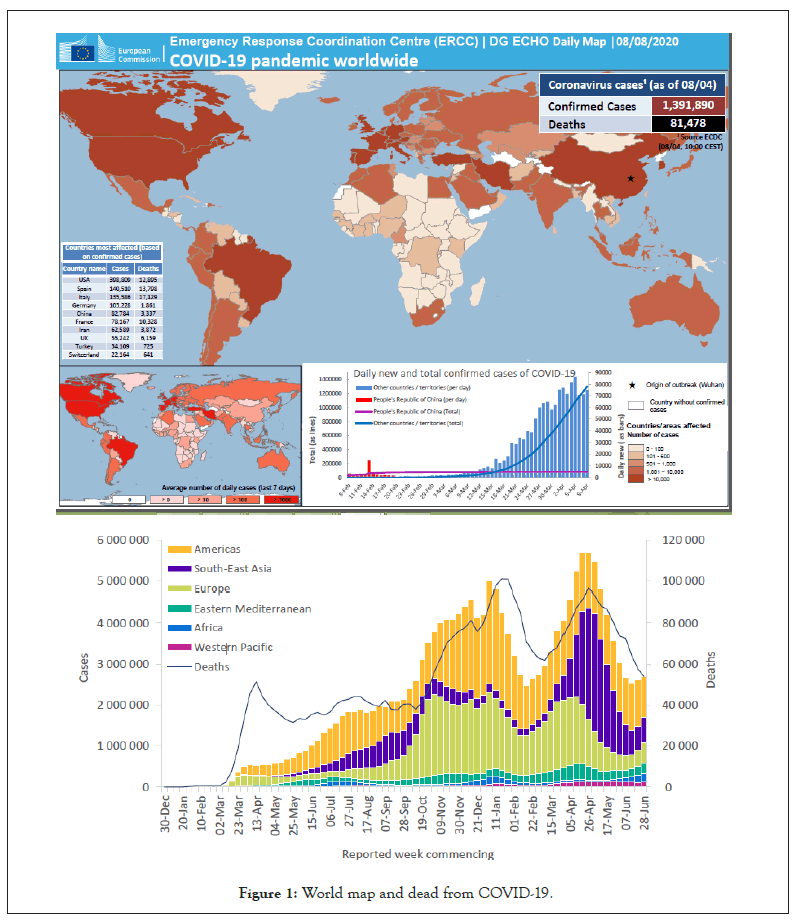
Figure 1: World map and dead from COVID-19.
Some cases are fatal. On 30th January 2020 the recommendations of the Emergency Committee, the WHO Director General declared that the outbreak constitutes a Public Health Emergency of International Concern. Coronaviruses (CoV) were identified as human pathogens in the 1960s. Coronaviruses belong to the Coronaviridae family in the Nidovirales order. Corona represents crown-like spikes on the outer surface of the virus; thus, it was named as a coronavirus. Coronaviruses are enveloped viruses, minute in size (65-125 nm in diameter) and contain a single- stranded RNA as a nucleic material, size ranging from 26 kbs to 32 kbs in length (Figure 2).
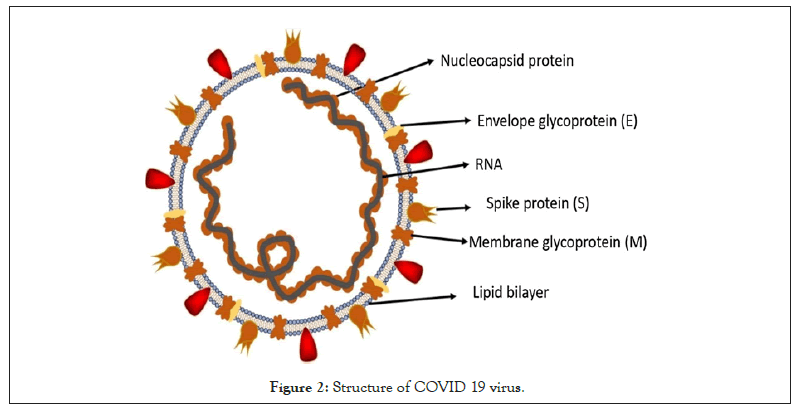
Figure 2: Structure of COVID 19 virus.
Most coronaviruses infect animals, (i.e., bats, birds and mammals), which act as an intermediate host reservoir. Sometimes they change host and infect humans. Previous Coronaviruses have included SARS-CoV and MERS CoV. Severe acute respiratory syndrome coronavirus 2 (SARS-CoV-2) is a new strain of coronavirus that has not been previously identified in humans (Figure 3).
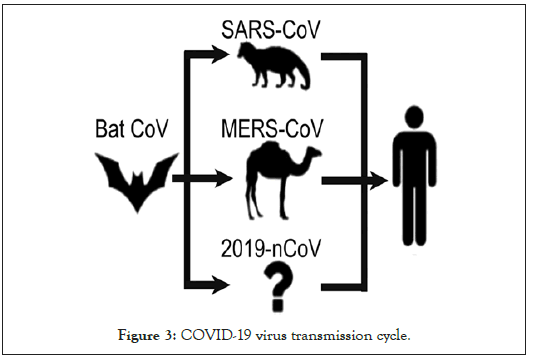
Figure 3: COVID-19 virus transmission cycle.
All these facts together have propelled the prospection for new antiviral drugs, particularly from natural products, as they constitute more than 25% of the new drug prototypes approved in the last decades. Among sources of natural products, animal venoms have revealed a great potential for drug discovery, and despite the harmful mechanism of animal venoms, most of them have components holding potential medicinal properties to cure diseases. It is widely reported in the literature that animal venoms are rich sources of antimicrobial substances, and contain a vast array of active biological compounds with distinct chemical structures.
Belong to the order Hymenoptera. Most advanced group of insects. The bee colony needs three components to function normally for a long time. The queen, number of drones,“army” of worker bees. Figure 4 shows the global distribution of honey bee (Apis mellifera)
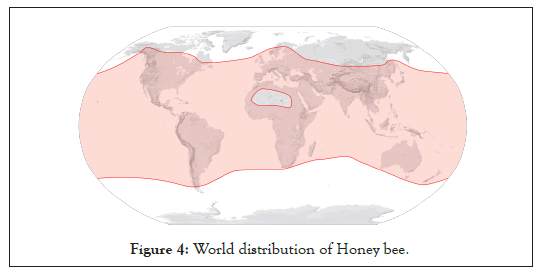
Figure 4: World distribution of Honey bee.
In the oldest book of India honey and bees were mentioned for several times. Bee venom therapy was practiced in ancient Egypt, Greece, and China-three Great Civilizations known for highly developed medical systems. Hippocrates recognized the healing virtues of bee venom for treating arthritis and other joint problems. In Egyptian civilization the bee is the symbol of the king Honey was mentioned in ancient Greek literary works-Iliad and Odyssey.
Bee venom composed of natural peptides. However, antiviral properties of BV have not well investigated and also its mechanisms are not fully understood
BV is a bitter colorless liquid (pH 4.5-5.5) that dries up easily even at room temperature and is soluble in water but insoluble in alcohol and ammonium sulfate. A bee can inject to 0.1 mg venom via its stinger. It has been reported to be similar to the toxin of the sea nettle (Figure 5).
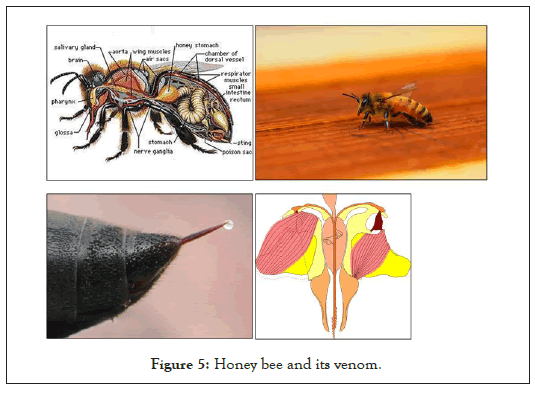
Figure 5: Honey bee and its venom.
Bee venom (BV) has been utilize as a traditional medicine for the treatment of rheumatism, arthritis, skin diseases, cancerous tumors, and back pains due to its antibacterial, antiviral and anti- inflammatory effects. Therefore, these results provide the evidence that BV and MLT could be a potential source as a promising antiviral agent, especially to develop as a broad spectrum antiviral agent. Table 1 indicates the contents of honey bee venom.
| Name | % | Function |
|---|---|---|
| Melitten | 52 | Anti-inflammatory agent; induces of cortisol production; cell-lytic. |
| Apamin | 15-20 | Cortisol production; neurotoxin |
| Phospholipase A2 (A1 in wasps) | 10-12 | Cell-lytic; decreases blood pressure; anticoagulant; prostoglandin stimulant |
| Hyaluronidase | 01-03 | Dilates capillaries speeding inflammatory spread |
| Protease Inhibitors | 2 | Prevents Inactivation of other constituents |
| Dopamine & noradrenalin | 01-02 | Increases pulse rate |
| Histamine | 0.5-2 | Allergic response |
Table 1: Contents of honey bee venom.
In a study, researchers investigated the antiviral activity of BV and its components against enveloped and non-enveloped viruses including RNA and DNA viruses in vitro and attempted to understand the mechanism of this property is mainly owing to the virucidal effect of both BV and MLT.
Additionally, they evaluated the antiviral activity of MLT against lethal doses of pathogenic influenza A H1N1 viruses in mice in vivo [1]. Co-incubation of non-cytotoxic amounts of BV and MLT, the main component of BV, significantly inhibited the replication of enveloped viruses such as Influenza A virus (PR8), Vesicular Stomatitis Virus (VSV), Respiratory Syncytial Virus (RSV), and Herpes Simplex Virus (HSV). Additionally, BV and MLT also inhibited the replication of non-enveloped viruses such as Enterovirus-71 (EV-71) and Coxsackie Virus (H3). Such antiviral properties were mainly explained by virucidal mechanism. Moreover, MLT protected mice which were challenged with lethal doses of pathogenic influenza A H1N1 viruses. In summary, this study demonstrated that BV and MLT derived from BV exhibited potent antiviral activity against various enveloped and non- enveloped viruses in vitro and Influenza virus in the in vivo mouse model. Moreover, its antiviral mechanism has been confirmed to involve direct interaction with the viral surface [2-4].
Apart from BV virucidal activity, BV can stimulate type I IFN, which subsequently could stimulate the antiviral state in the host cell and also inhibit the viral replication. Taken together, these results suggest that BV or MLT has potential to become prophylactic or therapeutic agent for infectious viral diseases [5,6].
From 23 February to 8 March 2020, a total of 5,115 beekeepers were surveyed, including 723 in the city of Wuhan, the epicentre of COVID-19 in China. Surprisingly, none of the beekeepers developed symptoms related to COVID-19. The researchers then interviewed five bee apitherapists in Wuhan and followed 121 patients who received apitherapy from October 2019 to December 2019 [7-14]. Of note, all five apitherapists apply self-apitherapy for their own healthcare. Of the five apitherapists, two were exposed to suspect COVID-19 cases and the rest were exposed to confirmed cases without any protective measures. None of them were infected eventually [15,16]. Of the 121 patients, none were also infected by SARS-CoV-2, even though three of them had close contact with immediate family members with confirmed SARS-CoV-2 infection [17]. According to the researchers, it was possible that the beekeepers were less likely to be exposed to SARS-CoV-2 because they lived in less densely populated rural areas. However, the five apitherapists and their patients were from densely populated areas in Wuhan, and they seemed to have one thing in common: A tolerance to bee sting. Although bee stings can cause allergic reactions and can even result in death due to the excessive stress response of the immune system, bee venom can enhance the differentiation of human regulatory T cells, which play an important role in control of SARS- CoV infection [18-20].
Challenge health authorities all around the planet. Some viral vaccines have taken too long to be designed and approved for human and animal utilization, and even in some cases could not be developed. Preventive and curative measures should always be in the hands of health authorities to ensure control of epidemics, such as the recent Ebola virus in Africa or arboviruses, particularly in Brazil-represented by the dengue, chikungunya and Zika viruses- or worldwide pandemics, such as influenza, HIV and SARS-CoV-2.
Therefore, prospection, screening and all other phases of biological activity, validation, clinical development of animal peptides represent an essential scientific investment for protecting and perpetuating humankind. Due to historical background of honey bee venom for control of different diseases, further investigations are required for evaluation of this product against COVID-19 disease.
Citation: Akbari K, Ostadtaghizadeh A, Vatandoost H (2022) The Impact of Honey Bee Venom for the Control of COVID-19. J Infect Dis Preve Med. 10: 256.
Received: 29-Dec-2021, Manuscript No. JADPR-22-15282; Editor assigned: 31-Dec-2021, Pre QC No. JADPR-22-15282 (PQ); Reviewed: 05-Jan-2022, QC No. JADPR-22-15282; Revised: 12-Jan-2022, Manuscript No. JADPR-22-15282 (R); Published: 19-Jan-2022 , DOI: 10.35841/2329-8731.22.10.256
Copyright: © 2022 Akbari K, et al. This is an open-access article distributed under the terms of the Creative Commons Attribution License, which permits unrestricted use, distribution, and reproduction in any medium, provided the original author and source are credited.